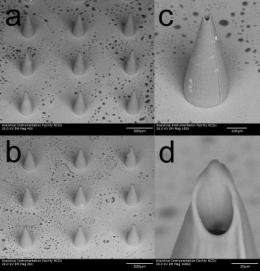Microneedle, quantum dot study opens door to new clinical cancer tools

Researchers from North Carolina State University have developed extremely small microneedles that can be used to deliver medically-relevant nanoscale dyes called quantum dots into skin - an advance that opens the door to new techniques for diagnosing and treating a variety of medical conditions, including skin cancer.
"We were able to fabricate hollow, plastic microneedles using a laser-based rapid-prototyping approach," says Dr. Roger Narayan, one of the lead researchers, "and found that we could deliver a solution containing quantum dots using these microneedles." Microneedles are very small needles in which at least one dimension - such as length - is less than one millimeter. Narayan is a professor in the joint biomedical engineering department of NC State's College of Engineering and the University of North Carolina at Chapel Hill.
"The motivation for the study was to see whether we could use microneedles to deliver quantum dots into the skin," Narayan says. "Our findings are significant, in part, because this technology will potentially enable researchers to deliver quantum dots, suspended in solution, to deeper layers of skin. That could be useful for the diagnosis and treatment of skin cancers, among other conditions." Quantum dots are nanoscale crystals with unique properties in terms of light emission. They hold promise as a tool in medical diagnosis.
The researchers created the plastic microneedles and tested them using pig skin, which has characteristics closely resembling human skin. Using a water-based solution containing quantum dots, the researchers were able to capture images of the quantum dots entering the skin using multiphoton microscopy. These images show the mechanism by which the quantum dots enter the layers of skin, allowing the researchers to verify the effectiveness of the microneedles as a delivery mechanism for quantum dots.
The imaging method used in this study, multiphoton microscopy, may have clinical applications for real-time imaging of dyes - such as quantum dots - in the skin. This could contribute to more rapid diagnosis of cancers or other medical problems.
The study is also significant because it shows that a laser-based rapid prototyping approach allows for the creation of microneedles of varying lengths and shapes. This will allow physicians to create microneedles that are customized for treatment of a specific condition.
Specifically, the microneedles were created using two-photon polymerization, an approach pioneered by NC State and Laser Zentrum Hannover for use in medical device applications. Two-photon polymerization allowed the researchers to create hollow, plastic microneedles with specific design characteristics. "Our use of this fabrication technology highlights its potential for other small-scale medical device applications," Narayan says.
More information: A paper describing the study, "Multiphoton microscopy of transdermal quantum dot delivery using two photon polymerization-fabricated polymer microneedles," will be published in the September issue of Faraday Discussions.
Provided by North Carolina State University

















